
The Orange Line - project n° 3
Brief History: "In 1966, the Montreal metro had 26 stations. Since 2007, there are 68. All are
operated by the Société de transport de Montréal, including the station at the city of Longueuil and the three inaugurated at the city of Laval, in 2007.
From the beginning of construction in the early 1960s, the designers of the Montreal metro wanted each station to be unique. So they hired several architects to build the stations. From the 1970s, architects were tasked with integrating art and architecture from a station’s early design stages. Some created the artwork themselves, others commissioned them from artists."
The stations are divided into four lines: the Green Line, the Orange Line, the Blue Line and the Yellow Line. Click on the word Subway to see the network map.
For a month in the summer of 2019, alone I visited all 68 stations. I spent 6-8 hours a day going from station to station. Going up and down the steps, escalators and elevators. Each time, I looked at the different stations inside and outside, and I took pictures. In all, about 2000 photos.
In total, I show you photos taken at 41 stations. Sometimes just one photo or several.
The length of the Orange Line is approx. 24.8 kilometers (15.4 miles) with 31 stations. I show you 18 in total in two projects.
My information about the stations has been taken from this link:
and for the artworks to this other:
CHAMP-DE-MARS
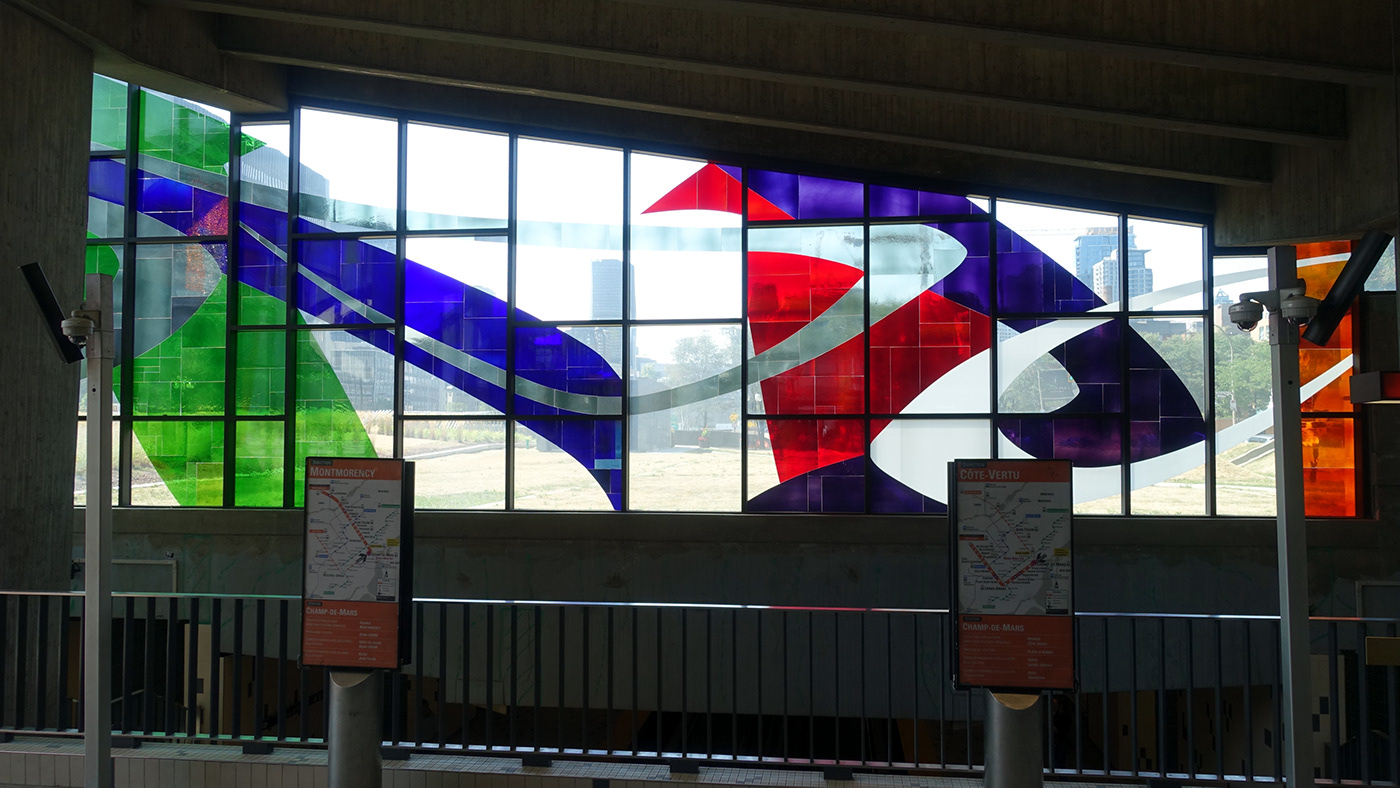
Champ-de-Mars station is located in the borough of Ville-Marie in Montreal and serves the Orange Line. It is located in Old Montreal by the Champ-de-Mars park. It opened on October 14, 1966, as part of the original Metro network.
Designed by Adalbert Niklewicz, it is a normal side platform station, built in open cut due to the presence of weak Utica shale in the surrounding rock. Its entrance is located near a series of tunnels that cross the Ville-Marie Highway, giving access to Old Montreal.
This station is named for Champ-de-Mars, a public park facing Montreal City Hall.
(Champ-de-Mars Wikipedia)


One of the most important artworks in the Metro, a set of stained glass windows by noted Quebec artist Marcelle Ferron, illuminates the mezzanine of this station. These windows, one of the artist's masterpieces and her most famous work, were given by the Government of Quebec in 1968. They were the first work of non-figurative art to be commissioned for the Metro, representing the first official entrance of Automatist art in the system. Her work can be seen from inside and outside the station. (Champ-de-Mars Wikipedia)
Born in Louiseville, Marcelle Ferron (1924-2001) made her artwork accessible by integrating it into the architecture of public buildings. As she said, “My aim has always been modest: to transform the arranged marriage [of art and architecture] into a love match.”

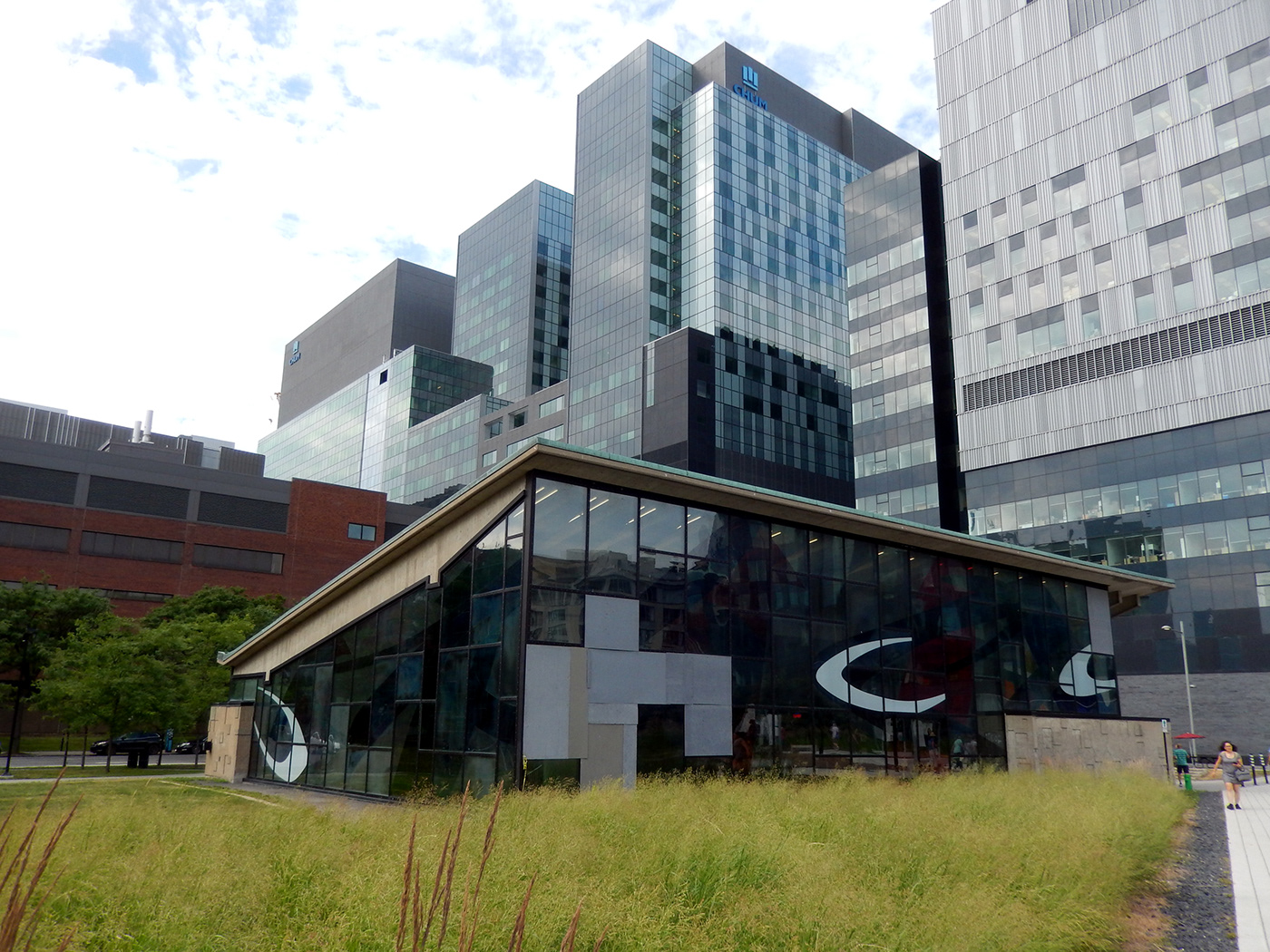
In 2019, when I went to the Champ-de-Mars station, part of the mural was under repair.

LAURIER


Laurier station is located in the borough of Le Plateau-Mont-Royal and serves the Orange Line. The station opened on October 14, 1966, as part of the original network of the Metro.
The station, designed by Jean P. Pothier, is a normal side platform station, built in tunnel. It has a mezzanine and an entrance at either end, the southern one incorporating an open sided bus shelter, and the northern one including an automatic ticket barrier.
The walls are decorated in grey granite, with orange and red tiles at both ends of the platform.
This station is named for Laurier Avenue, named for Sir Wilfrid Laurier (1841–1919), the first French-Canadian Prime Minister of Canada (1896–1911). (Laurier Wikipedia)

ROSEMONT

Rosemont station is located in the borough of Rosemont--La Petite-Patrie and serves the Orange Line. The station opened on October 14, 1966, as part of the original network of the Metro.
The station, designed by Duplessis, Labelle et Derome, is a normal side platform station built into a tunnel. It has a ticket barrier at transept level that leads to a single entrance, adjacent to a bus loop and to a municipal parking lot.
This station is named for boulevard Rosemont, the main street of the Rosemont district. This area was developed on an area purchased by land speculators Ucal-Henri Dandurand and Herbert Holt from the Canadian Pacific Railway; it was incorporated as the Village of Rosemont in 1915, named by Dandurand in honour of his mother, born Rose Phillips. (Rosemont Wikipedia)


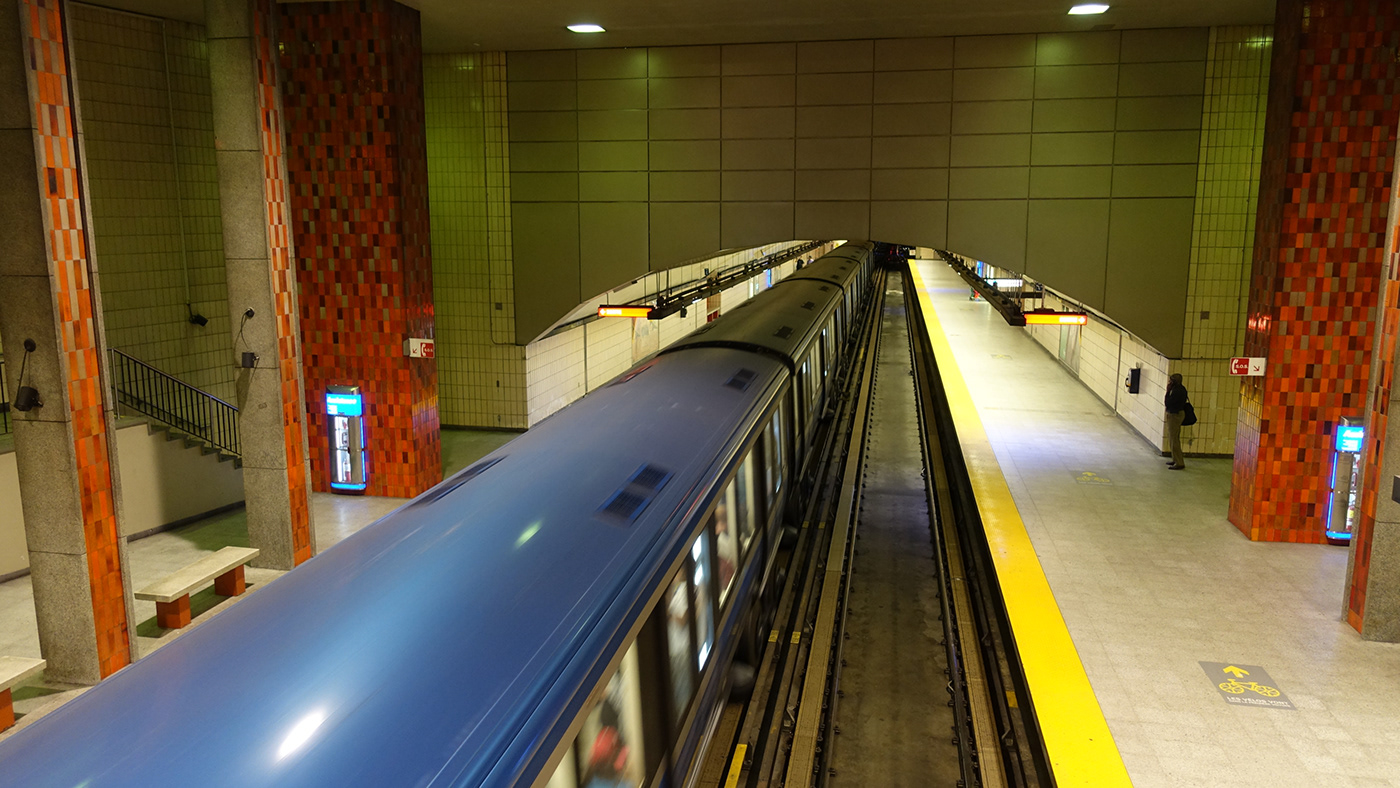
JARRY


Jarry station is located in the borough of Villeray--Saint-Michel--Parc-Extension and serves the Orange Line. The station opened on October 14, 1966, as part of the original network of the Metro.
The station, designed by Lemoyne, Bland, Edwards, & Shine, is a normal side platform station, built in tunnel. The mezzanine near the north end is connected to an entrance integrated into the ground floor of an apartment building. The station is known for the diamond-shaped caissons in the ceiling of the transept.
This station is named for rue Jarry, which in turn commemorates Bernard Bleignier dit Jarry, who received a concession in 1700 that later became the village of Saint-Laurent. The street was built on land belonging to Stanislas Bleignier Jarry Sr. (patriarch), a descendant of Bernard Jarry, who was mayor of the village in 1907. Stanislas' son was Raoul Jarry. (Jarry Wikipedia)

CRÉMAZIE
Crémazie station is located on the border between the boroughs of Ahuntsic-Cartierville and Villeray–Saint-Michel–Parc-Extension. It is opened October 14, 1966 and serves the Orange Line.
The station, designed by Adalbert Niklewicz, is a normal side platform station, built in tunnel. A large volume serves as the transept, with three of the four platform stairways in enclosed tunnels.
The mezzanine serves two entrances, one on each side of the Metropolitan Highway, and both integrated into buildings; the northern access has doors both in front of and behind the building.
This station is named for Crémazie Boulevard, in turn commemorating Octave Crémazie (1827–1879), one of Quebec's most important poets. The street was so named in 1914. (Wikipedia)

"Le poète dans l’univers" (1968) ("The poet in the universe") by Georges Lauda, Paul Pannier and Gérard Cordeau.
This mural is an homage to Québec poets Hector de Saint-Denys Garneau, Émile Nelligan, and Octave Crémazie. The poets themselves are represented by cast-iron masks, mounted on a large ceramic relief featuring the symbols for the planets and the signs of the zodiac. Crémazie
In close-up, the extracts of the works of the three poets on the fresco. Followed by the lyrics in French and English, just below.



"Ma pensée est couleur de lumières lointaines du fond de quelque crypte aux vagues profondes.
My thought is colored by distant lights from the bottom of some crypt with deep waves."
Émile Nelligan
To read the entire poem "L'âme du poète" : L'âme du poète
His biography: Émile Nelligan - Wikipedia
"A-t-on le droit de faire la nuit sur le monde et sur notre cœur pour une étincelle?
Do we have the right to make night over the world and our hearts for a spark?"
Hector de Saint-Denys Garneau
"Tous ceux dont le cœur pur n'écoute sur la terre que les échos du ciel rendent moins amère et la douloureuse voie où l'homme doit marcher.
All those whose pure hearts listen on earth only to the echoes of heaven make less bitter and the painful path where man must walk."
Octave Crémazie
To read the entire poem "Les Morts": Les Morts
His biography: Octave Crémazie - Wikipedia
HENRI-BOURASSA

Henri-Bourassa station is located in the borough of Ahuntsic-Cartierville and serves the Orange Line. Designed by Janusz Warunkiewicz, this station is a normal side platform station, connected by a transept and a long tunnel to a mezzanine some distance away. The station opened October 14, 1966.
The station was upgraded as part of the extension to Laval, by André Léonard and Claude Leclerc. The extension opened to the public on April 28, 2007. On April 26, 2010, Henri-Bourassa became the 6th station to be accessible to the mobility-impaired.
This station is named for Henri Bourassa Blvd. which in turn is named for Henri Bourassa (1868–1952), a journalist and politician. (Henri-Bourassa Wikipedia)

The station includes several works of art. In 2019, I just photographed this stainless steel and LED work entitled "98" (2007) by Axel Morgenthaler. This mural is composed of 98 tricolor LED lights. The images suggest Inca iconography, elements of nature, infrared photographs and astronomical images. As on a TV screen or computer monitor, the three basic colours (red, green, and blue) allow millions of colours to be displayed.
Born in Bern, Switzerland, in 1965, Axel Morgenthaler studied electronics and theatre before combining the two disciplines. Describing himself as a light sculptor, he has created more than 100 lighting and stage designs.

CARTIER (city of Laval)

Cartier station is a Montreal Metro station located in the city of Laval, in the Pont-Viau district. Operated by the Montreal Transit Corporation (STM) and serves the Orange Line. This station is part of an extension into Laval, and is inaugurated on April 28, 2007.
It is a normal side platform station. The station's main entrance, adjoining the bus terminal, takes the form of a right triangle, with the legs parallel to the streets and the hypotenuse parallel to the tracks, thereby bringing the aboveground and underground world into relation.
The station is named for nearby Boulevard Cartier, which in turn was named for George-Étienne Cartier, a French-Canadian statesman and Father of Confederation. (Cartier Wikipedia)

DE LA CONCORDE (city of Laval)

De la Concorde station is an intermodal station located in the city of Laval, in the Laval-des-Rapides district. It serves the Montreal Metro's Orange Line and connects to Exo's Saint-Jérôme commuter rail line. It is opened April 28, 2007, as part of Montreal Metro's extension into Laval.
The entrance building is split-level, the lower providing access to the Metro station and the upper level to the train station.
The station is a side platform station, built in tunnel with an open-pit central section in the shape of a cube. The upper surface of the cube protrudes out of the earth and is rimmed with skylights, producing a sundial-like effect as the progress of the sun changes the light within the cube. The station's decor is primarily bare concrete, metal, and steel, with the platform's ultramarine tiles and enlarged photographs of grass providing colour.
The station is named after boulevard de la Concorde, which in turn is named for the Place de la Concorde in Paris. (De La Concorde Wikipedia)



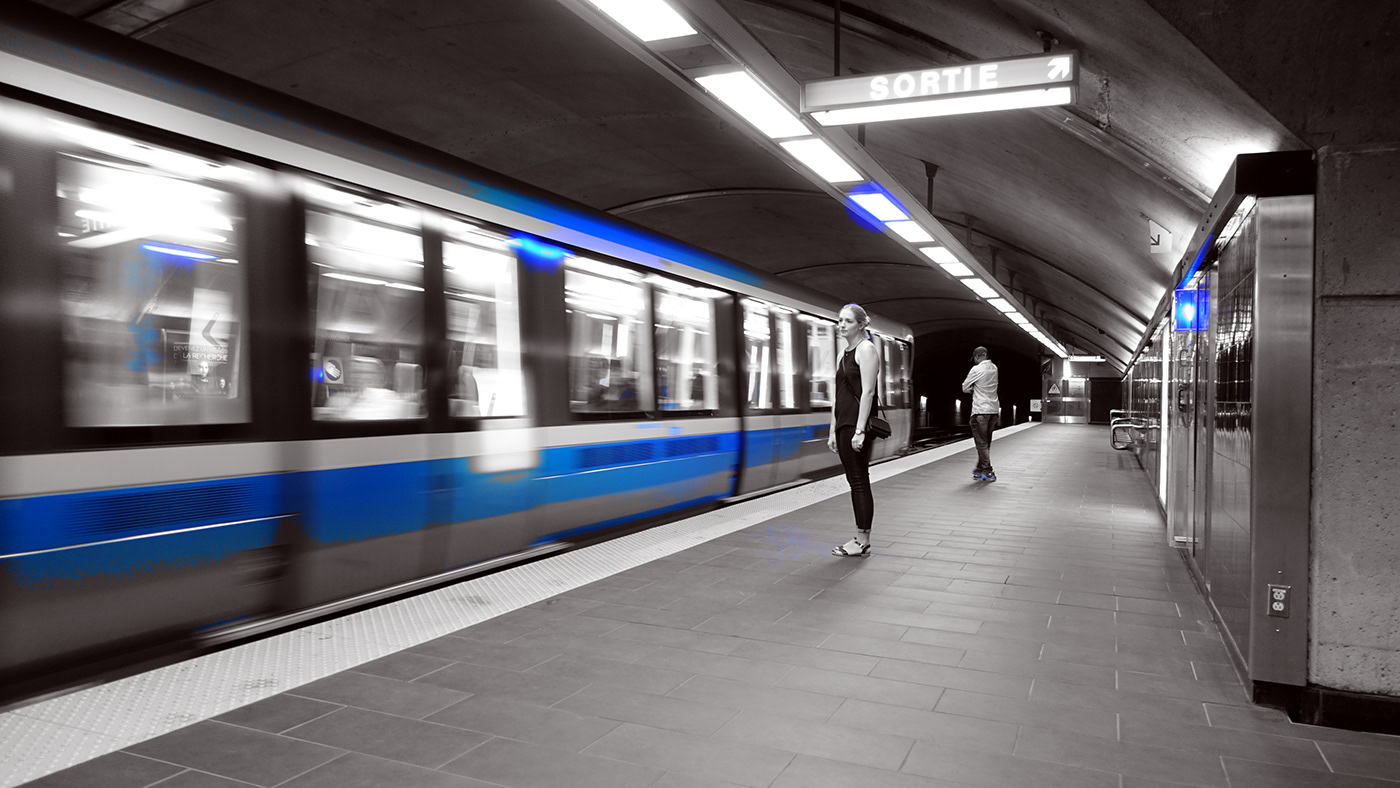
I had just bought my Sony camera and while I was going from one station to another to photograph the stations, I was experimenting with the special effects of my camera. I hesitated to publish this picture because I had photographed this woman without her permission, but I really like the photo.
MONTMORENCY (city of Laval)


Montmorency station is a Montreal Metro station located in the city of Laval and serves the Orange Line. This station is part of an extension into Laval, becoming the northern terminus of the Orange Line. It is inaugurated on April 28, 2007.
It is a normal side platform station. This station has the highest ceilings of any station in the network. The wall panels are decorated with tiling in diagonal stripes of retro shades of cyan, navy, straw yellow and brick red.
The station is equipped with the MétroVision information screens which displays news, commercials, and the waiting time until the arrival of the next train.
Located across the street from Cégep* Montmorency, this college got its name from François de Montmorency-Laval (1623–1703), the first bishop of Quebec and New France from 1674 to 1688. (Montmorency Wikipedia)
*Cégep is the name of the public colleges in Quebec that offer pre-university programs.

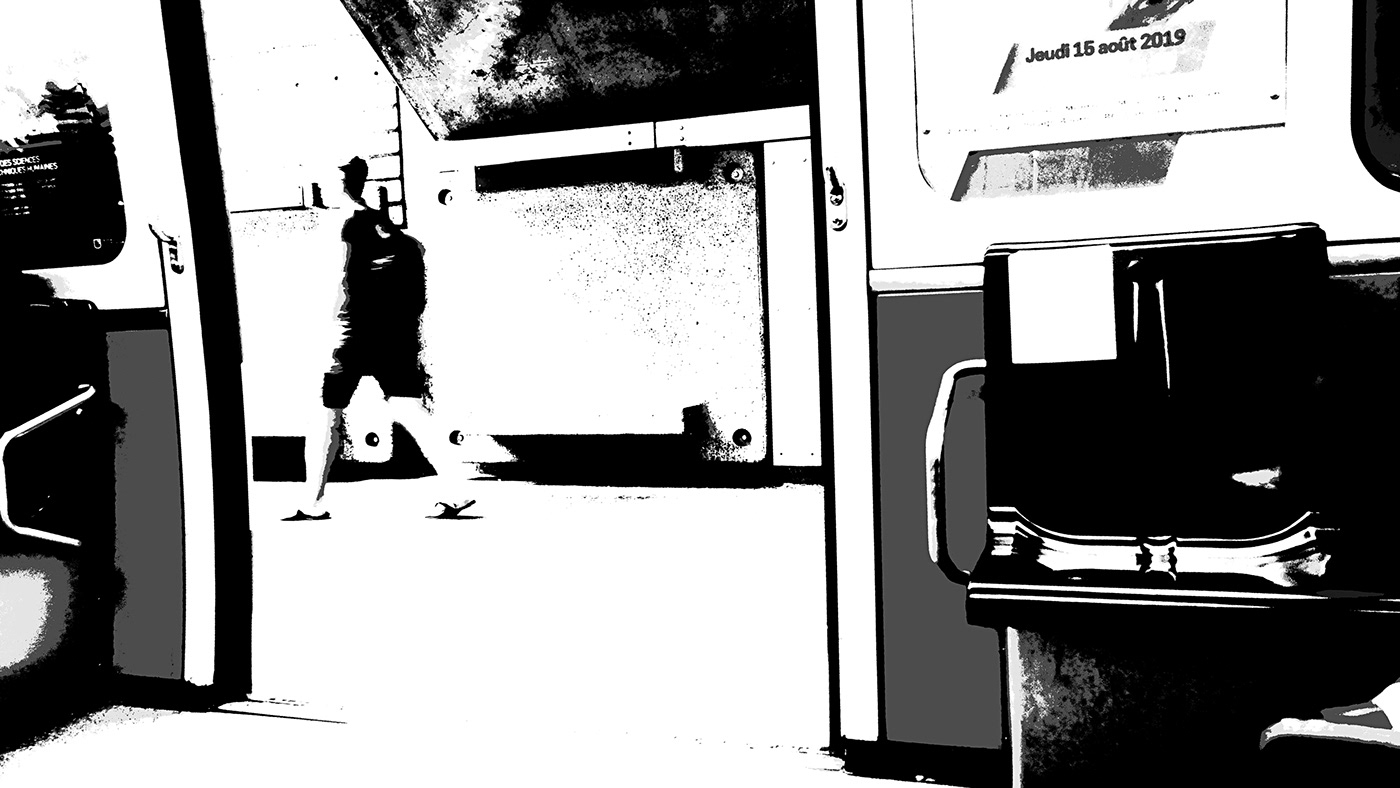
Thank you for watching!




